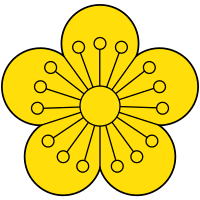Korean won
The won (/wʌn/;[1] Korean: 원(圓), Korean pronunciation: [wʌn]) was the currency of Korea between 1902 and 1910. It was subdivided into 100 jeon (/dʒʌn/;[2] Korean: 전(錢), Korean pronunciation: [tɕʌn]).
| Korean won | |
| Hunminjeongeum | 원, 전 |
|---|---|
| Hanja | 圓, 錢 |
| Revised Romanization | won, jeon |
| McCune–Reischauer | wŏn, chŏn |
Etymology
Won is a cognate of the Chinese yuan and Japanese yen.
History
The won was introduced in 1902, replacing the yang at a rate of 1 won = 5 yang. Units: 1 won = 100 chon/銭, 1 chon = 5 poon/分(fun ec. yesteryear spellings) of the preceding currency. In 1909, the Bank of Korea (한국은행; 韓國銀行) was founded in Seoul as a central bank and began issuing currency of a modern type. The won was equivalent to the Japanese yen and was replaced by the Korean yen in 1910 during the Colonial Era. In 1910, the Bank of Korea was renamed the Bank of Joseon (Korean: 조선은행; 朝鮮銀行), which issued notes denominated in yen and sen.
Coins

Coins were minted in the denominations of ½, 1, 5, 10 and 20 chon, ½, 5, 10 and 20 won. The coins all carried the title of the "state", Daehan (대한; 大韓), and the Korean era name, Gwangmu (광무; 光武) and then Yunghui (융희;隆熙), whilst the specifications were equivalent to the coins of the Japanese yen.
| Korean Won Coins | |||
|---|---|---|---|
| Obverse | Reverse | Denomination | Composition |
 |
 |
½ chon | Bronze |
 |
 |
1 chon | |
 |
 |
5 chon | Cupronickel |
 |
 |
10 chon | 800‰ silver |
 |
 |
20 chon | |
 |
 |
½ won | |
 |
 |
5 won | 900‰ gold |
 |
 |
10 won | |
 |
20 won | ||
Banknotes
No banknotes were issued denominated in won. However, Korean yen notes were issued by Dai Ichi Ginko (First National Bank (of Japan), 주식회사제일은행, 株式會社第一銀行).
See also
References
- ↑ "won". OxfordDictionaries.com. Oxford University Press. Retrieved 8 January 2017.
- ↑ "jeon". OxfordDictionaries.com. Oxford University Press. Retrieved 8 January 2017.
Further reading
- Schuler, Kurt. "Tables of Modern Monetary History: Asia". Retrieved 2004-02-29.
- Krause, Chester L.; Clifford Mishler (2003). 2004 Standard Catalog of World Coins: 1901–Present. Colin R. Bruce II (senior editor) (31st ed.). Krause Publications. ISBN 0873495934.
- Krause, Chester L.; Clifford Mishler (2004). Standard Catalog of World Coins: 1801–1900. Colin R. Bruce II (senior editor) (4th ed.). Krause Publications. ISBN 0873497988.
| Preceded by: Korean yang Reason: heavier influence by Japan Ratio: 1 won = 5 yang |
Currency of Korea 1902 – 1910 Concurrent with: Korean yen |
Succeeded by: Korean yen Reason: complete annexation by Japan Ratio: at par |